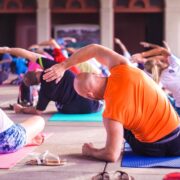
How to Do the Good Morning Exercise—And Why You …
The Good Morning Exercise is a compound movement that primarily targets the lower back muscles, but also engages the hamstrings, glutes, and core. It involves bending forward at the hips while keeping a straight back, mimicking the motion of bowing or greeting someone in the morning. This exercise is commonly performed with a barbell across the shoulders, but can also be done with dumbbells or bodyweight.
The origin of the Good Morning Exercise can be traced back to weightlifting and powerlifting communities. It was first popularized by Russian weightlifters in the early 20th century as a way to strengthen the lower back and improve overall athletic performance. Over time, it has become a staple exercise in strength training programs and is now widely recognized for its benefits in developing posterior chain strength and stability.
Key Takeaways
- The Good Morning Exercise is a compound exercise that targets the lower back, glutes, and hamstrings.
- Incorporating the Good Morning Exercise into your workout routine can improve posture, increase strength, and reduce the risk of injury.
- Proper form and technique for the Good Morning Exercise include keeping your back straight, hinging at the hips, and engaging your core.
- Equipment needed for the Good Morning Exercise includes a barbell, weights, and a squat rack.
- Variations of the Good Morning Exercise for different fitness levels include using dumbbells, resistance bands, or performing the exercise on a stability ball.
Benefits of Incorporating the Good Morning Exercise into Your Workout Routine
1. Strengthening of the lower back muscles: The Good Morning Exercise is one of the most effective exercises for targeting and strengthening the muscles of the lower back, including the erector spinae. By regularly performing this exercise, you can help prevent lower back pain and improve your overall spinal stability.
2. Improved posture and balance: The Good Morning Exercise requires you to maintain a straight back throughout the movement, which helps improve your posture and spinal alignment. Additionally, it engages your core muscles, which are essential for maintaining balance and stability.
3. Increased flexibility and mobility: The deep hip hinge motion involved in the Good Morning Exercise helps improve flexibility and mobility in the hamstrings, glutes, and hips. This can be particularly beneficial for individuals who spend long periods sitting or have tight hip flexors.
4. Enhanced athletic performance: The Good Morning Exercise targets many of the muscles used in explosive movements such as sprinting, jumping, and lifting heavy objects. By incorporating this exercise into your routine, you can improve your power output and overall athletic performance.
5. Burning of calories and fat: The Good Morning Exercise is a compound movement that engages multiple muscle groups, making it an effective calorie-burning exercise. By incorporating this exercise into your workout routine, you can increase your overall energy expenditure and promote fat loss.
Proper Form and Technique for the Good Morning Exercise
To perform the Good Morning Exercise correctly, follow these steps:
1. Start by standing with your feet shoulder-width apart and a slight bend in your knees.
2. Place a barbell across your upper back, resting it on your trapezius muscles. Alternatively, hold dumbbells at your sides or perform the exercise with just your bodyweight.
3. Engage your core and maintain a straight back throughout the movement.
4. Slowly hinge forward at the hips, pushing your glutes back as if you were trying to touch your toes with your fingertips.
5. Continue bending forward until you feel a stretch in your hamstrings, but be careful not to round your back.
6. Pause for a moment at the bottom of the movement, then reverse the motion by driving your hips forward and returning to the starting position.
Tips for maintaining proper form and technique:
– Keep your head in a neutral position, looking straight ahead or slightly upward.
– Engage your core muscles throughout the movement to maintain stability.
– Focus on pushing your hips back rather than bending forward at the waist.
– Keep a slight bend in your knees to avoid placing excessive stress on the lower back.
– Control the movement and avoid using momentum to lift the weight.
Common mistakes to avoid:
– Rounding the back: This is one of the most common mistakes when performing the Good Morning Exercise. It puts excessive stress on the spine and increases the risk of injury. Focus on maintaining a straight back throughout the movement.
– Using too much weight: It’s important to start with a weight that you can handle with proper form. Using too much weight can compromise your technique and increase the risk of injury.
– Not engaging the core: Your core muscles play a crucial role in stabilizing your spine during the Good Morning Exercise. Make sure to engage your core and maintain tension throughout the movement.
– Bending forward at the waist: The Good Morning Exercise is a hip hinge movement, not a bending movement at the waist. Focus on pushing your hips back and maintaining a straight back throughout the exercise.
Equipment Needed for the Good Morning Exercise
The Good Morning Exercise can be performed with various types of equipment, depending on your preference and access to gym equipment. Here are some options:
1. Barbell: This is the most common equipment used for the Good Morning Exercise. It allows you to progressively load the exercise and increase the resistance over time. To perform the exercise with a barbell, you will need access to a squat rack or power rack.
2. Dumbbells: If you don’t have access to a barbell or prefer using dumbbells, you can perform the Good Morning Exercise by holding dumbbells at your sides. This allows for greater freedom of movement and can be a good option for beginners or those with limited equipment.
3. Bodyweight: The Good Morning Exercise can also be performed using just your bodyweight. This is a great option for beginners or individuals who are new to strength training. To perform the exercise without any equipment, simply follow the same steps as described earlier, but without any added weight.
Alternatives for those who do not have access to gym equipment:
If you don’t have access to gym equipment, there are still ways to incorporate the Good Morning Exercise into your routine. Here are some alternatives:
1. Resistance bands: Resistance bands can be used to add resistance to the Good Morning Exercise. Simply step on the band with your feet and hold the other end of the band at your shoulders or behind your head. Perform the exercise as you would with a barbell, but with the added resistance from the band.
2. Kettlebell or sandbag: If you have access to a kettlebell or sandbag, you can use it as a substitute for a barbell or dumbbells. Hold the kettlebell or sandbag at your chest or on your shoulders and perform the exercise as described earlier.
3. Stability ball: A stability ball can be used to add an element of instability to the Good Morning Exercise, which can further engage your core muscles. Place the stability ball against a wall and lean against it with your upper back. Perform the exercise as you would with a barbell or dumbbells.
Variations of the Good Morning Exercise for Different Fitness Levels
The Good Morning Exercise can be modified to suit different fitness levels, from beginners to advanced. Here are some variations:
1. Beginners: If you’re new to the Good Morning Exercise or strength training in general, it’s important to start with lighter weights or just your bodyweight. Focus on mastering the technique and gradually increase the resistance over time. You can also perform the exercise with a stability ball against a wall for added support and stability.
2. Intermediate: Once you have mastered the basic form of the Good Morning Exercise, you can start adding more resistance by using a barbell or dumbbells. Increase the weight gradually and focus on maintaining proper form and technique throughout the movement.
3. Advanced: For advanced lifters, there are several ways to make the Good Morning Exercise more challenging. You can perform the exercise with a deficit, where your feet are elevated on a platform or step, increasing the range of motion. Another option is to perform single-leg variations of the exercise, such as single-leg Romanian deadlifts or single-leg Good Mornings.
Precautions and Safety Tips for Performing the Good Morning Exercise
While the Good Morning Exercise can be highly beneficial, it’s important to take certain precautions and follow safety guidelines to prevent injury. Here are some precautions and safety tips to keep in mind:
1. Consult with a healthcare professional: If you have any pre-existing injuries or medical conditions, it’s important to consult with a healthcare professional before incorporating the Good Morning Exercise into your routine. They can provide guidance on whether the exercise is suitable for you and any modifications you may need to make.
2. Start with lighter weights: When starting out, it’s important to start with lighter weights or just your bodyweight to allow your body to adapt to the exercise. Gradually increase the resistance over time as your strength and technique improve.
3. Warm up properly: Before performing the Good Morning Exercise, it’s important to warm up your muscles and joints to reduce the risk of injury. Incorporate dynamic stretches and mobility exercises for the lower back, hamstrings, and hips into your warm-up routine.
4. Use proper form and technique: Maintaining proper form and technique is crucial for preventing injury during the Good Morning Exercise. Focus on keeping a straight back, engaging your core, and pushing your hips back throughout the movement.
5. Listen to your body: Pay attention to how your body feels during the exercise. If you experience any pain or discomfort, stop immediately and reassess your form. It’s important to listen to your body and not push through pain.
How to Include the Good Morning Exercise in Your Full-Body Workout
The Good Morning Exercise can be incorporated into a full-body workout routine to target the posterior chain muscles and improve overall strength and stability. Here are some suggestions on how to include the exercise in your routine:
1. Warm-up: Start with a dynamic warm-up that includes exercises such as leg swings, hip circles, and cat-cow stretches to prepare your muscles and joints for the workout.
2. Compound exercises: Begin your workout with compound exercises that target multiple muscle groups, such as squats, deadlifts, or lunges. These exercises will help activate the muscles of the lower body and prepare them for the Good Morning Exercise.
3. Good Morning Exercise: Perform 3-4 sets of 8-12 repetitions of the Good Morning Exercise after your compound exercises. Start with lighter weights or just your bodyweight if you’re a beginner, and gradually increase the resistance over time.
4. Assistance exercises: After the Good Morning Exercise, incorporate assistance exercises that target specific muscle groups, such as hamstring curls, glute bridges, or back extensions. These exercises will further strengthen the posterior chain muscles and provide a well-rounded workout.
5. Core exercises: Finish your workout with core exercises that target the abdominal muscles, such as planks, Russian twists, or bicycle crunches. This will help improve core stability and support proper posture during the Good Morning Exercise.
Sample full-body workout plan including the Good Morning Exercise:
1. Warm-up:
– Leg swings: 2 sets of 10 swings per leg
– Hip circles: 2 sets of 10 circles in each direction
– Cat-cow stretches: 2 sets of 10 repetitions
2. Compound exercises:
– Squats: 3 sets of 8-12 repetitions
– Deadlifts: 3 sets of 8-12 repetitions
– Lunges: 3 sets of 8-12 repetitions
3. Good Morning Exercise:
– Barbell Good Mornings: 3-4 sets of 8-12 repetitions
4. Assistance exercises:
– Hamstring curls: 3 sets of 10-15 repetitions
– Glute bridges: 3 sets of 10-15 repetitions
– Back extensions: 3 sets of 10-15 repetitions
5. Core exercises:
– Planks: 3 sets of 30-60 seconds
– Russian twists: 3 sets of 10-15 repetitions
– Bicycle crunches: 3 sets of 10-15 repetitions
Common Mistakes to Avoid When Doing the Good Morning Exercise
1. Rounding the back: One of the most common mistakes when performing the Good Morning Exercise is rounding the back. This puts excessive stress on the spine and increases the risk of injury. Focus on maintaining a straight back throughout the movement and avoid rounding your shoulders or upper back.
2. Using too much weight: It’s important to start with a weight that you can handle with proper form. Using too much weight can compromise your technique and increase the risk of injury. Gradually increase the resistance over time as your strength and technique improve.
3. Not engaging the core: Your core muscles play a crucial role in stabilizing your spine during the Good Morning Exercise. Make sure to engage your core and maintain tension throughout the movement. This will help protect your lower back and improve overall stability.
4. Bending forward at the waist: The Good Morning Exercise is a hip hinge movement, not a bending movement at the waist. Focus on pushing your hips back and maintaining a straight back throughout the exercise. Avoid bending forward at the waist, as this can put excessive stress on the lower back.
5. Using momentum: It’s important to control the movement and avoid using momentum to lift the weight. Focus on using your muscles to perform the exercise rather than relying on momentum. This will ensure that you’re targeting the intended muscle groups and getting the most out of the exercise.
Progression and Advancement of the Good Morning Exercise
To continue challenging yourself and making progress with the Good Morning Exercise, here are some tips for progression and advancement:
1. Increase the resistance: As your strength and technique improve, gradually increase the resistance by adding more weight to the barbell or using heavier dumbbells. This will help continue to challenge your muscles and promote further strength gains.
2. Increase the range of motion: Once you have mastered the basic form of the Good Morning Exercise, you can increase the range of motion by performing the exercise with a deficit. Elevate your feet on a platform or step, which will increase the stretch in your hamstrings and engage your glutes and lower back even more.
3. Perform single-leg variations: To further challenge your stability and balance, you can perform single-leg variations of the Good Morning Exercise. This includes exercises such as single-leg Romanian deadlifts or single-leg Good Mornings. Start with lighter weights or just your bodyweight and gradually increase the resistance over time.
4. Incorporate supersets or circuits: To add an element of cardiovascular conditioning to your workout, you can incorporate supersets or circuits that combine the Good Morning Exercise with other exercises. This will help increase your overall energy expenditure and promote fat loss.
5. Experiment with different tempos: Another way to make the Good Morning Exercise more challenging is to experiment with different tempos. For example, you can perform the eccentric (lowering) portion of the movement slowly and under control, then explode back up to the starting position. This will help improve muscle control and increase time under tension.
Frequently Asked Questions About the Good Morning Exercise
Q: Is the Good Morning Exercise safe for individuals of all fitness levels?
A: The Good Morning Exercise can be safe for individuals of all fitness levels, but it is important to approach it with caution and proper form. It is recommended to start with lighter weights or no weights at all, especially for beginners or those with limited mobility. Gradually increase the weight as you become more comfortable and confident with the exercise. It is also important to listen to your body and stop if you experience any pain or discomfort. Consulting with a fitness professional or trainer can help ensure proper technique and reduce the risk of injury.
If you’re looking to enhance your morning routine, you might also be interested in learning about the benefits of using magnetic therapy. Magnetic therapy has been gaining popularity for its potential to alleviate pain, improve circulation, and promote overall well-being. In a recent article by Wave Magnets, they delve into the science behind magnetic therapy and how it can be incorporated into your daily routine. Discover more about this fascinating topic and explore the potential benefits of magnetic therapy by reading their article here.
FAQs
What is the Good Morning exercise?
The Good Morning exercise is a weightlifting exercise that targets the lower back, glutes, and hamstrings.
How do you perform the Good Morning exercise?
To perform the Good Morning exercise, stand with your feet shoulder-width apart, place a barbell on your shoulders, and hinge forward at the hips while keeping your back straight. Return to the starting position and repeat.
What are the benefits of the Good Morning exercise?
The Good Morning exercise can help improve lower back strength, increase glute and hamstring activation, and improve overall posture.
Is the Good Morning exercise safe?
The Good Morning exercise can be safe when performed with proper form and technique. It is important to start with a light weight and gradually increase the weight as you become more comfortable with the exercise.
Who should avoid the Good Morning exercise?
Individuals with lower back injuries or pain should avoid the Good Morning exercise. It is also important to consult with a healthcare professional before starting any new exercise program.

















